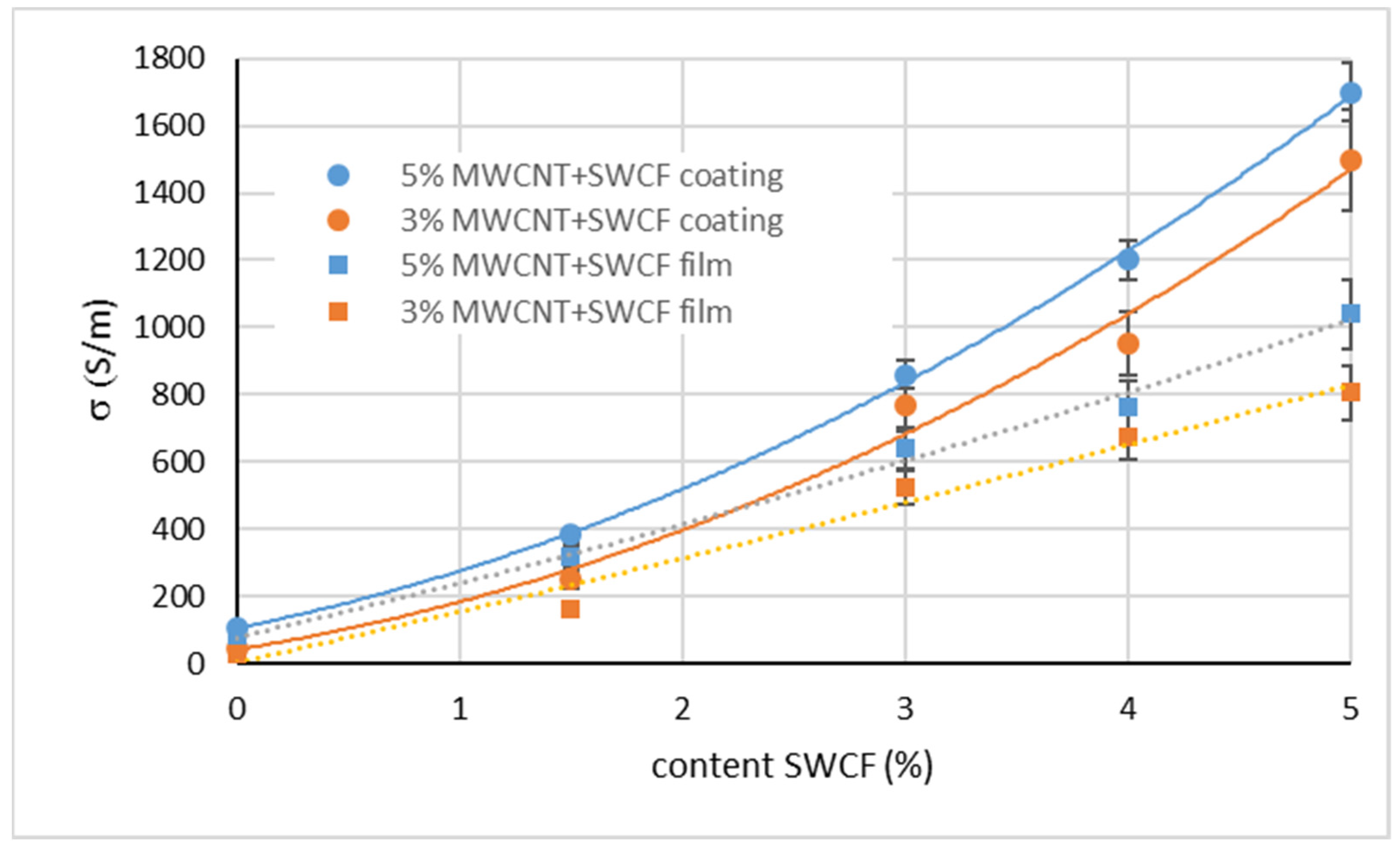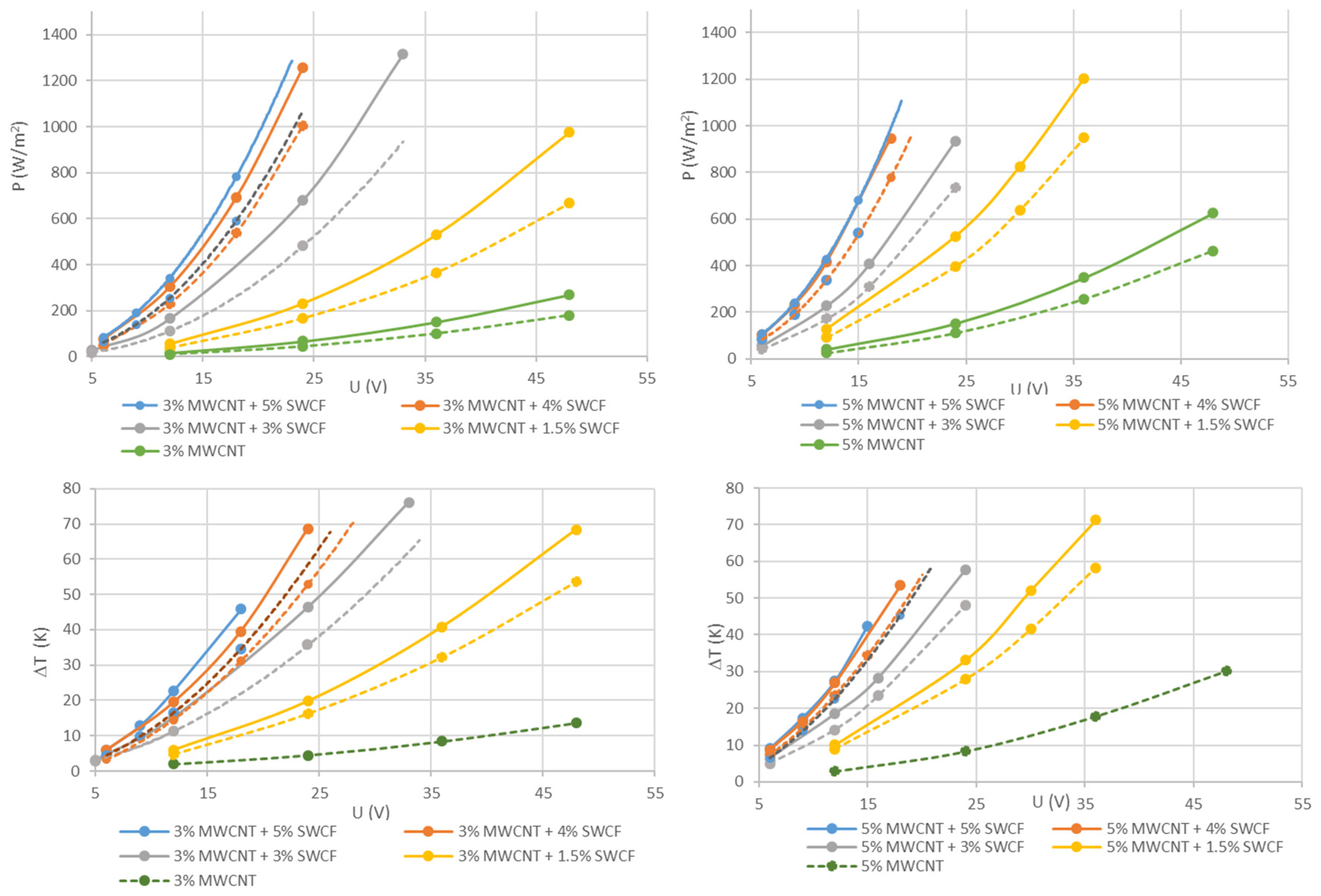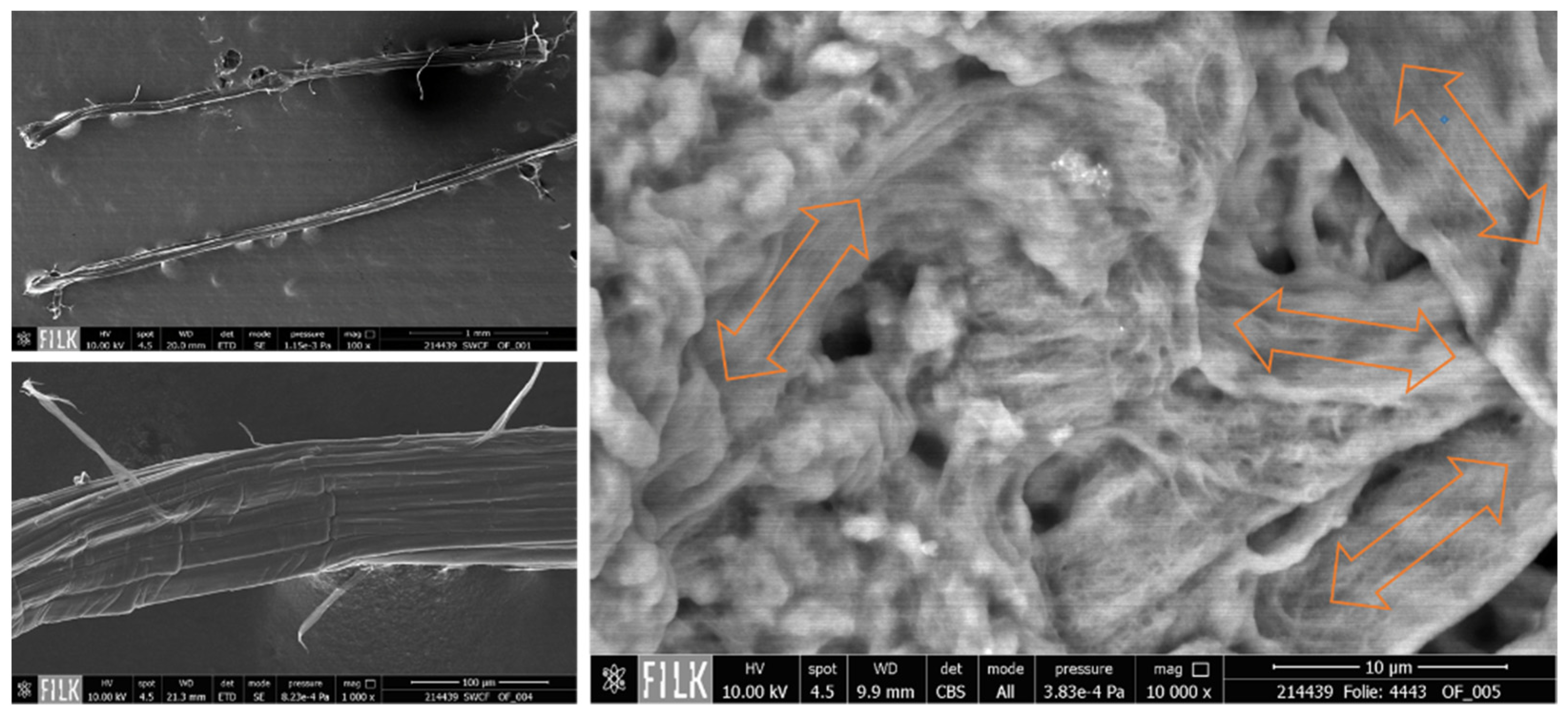Impact of Short-Cut SWCF Yarn on Conductivity and Electrical Heatability of Silicone–MWCNT Composites
Abstract
:1. Introduction
2. Materials and Methods
2.1. Chemicals
2.2. Preparation of Dispersions Containing MWCNT Particles and SWCF
- Breakdown of the MWCNT agglomerates without damaging the primary particles;
- Disentanglement of the MWCNT clusters or exfoliation of the MWCNT bundles;
- Formation of an MWCNT network in the polymer matrix.
2.3. Preparation of Conductive Silicone Composite Films
2.4. Measurement of Electrical Properties
2.4.1. Resistivity, Conductivity
2.4.2. Electrical Power per Unit Area
2.4.3. Heating Behavior
2.4.4. Micromorphological Characterization
3. Results and Discussion
3.1. Electrical Properties of Hybrid Composites
3.2. Heating Behavior of Hybrid Composites
3.3. Micromorphological Investigations
4. Conclusions
Author Contributions
Funding
Institutional Review Board Statement
Informed Consent Statement
Data Availability Statement
Acknowledgments
Conflicts of Interest
References
- Nair, S.S.; Mishra, S.K.; Kumar, D. Review–polymeric materials for energy harvesting and storage applications. Polym.-Plast. Technol. Mater. 2021, 60, 626–649. [Google Scholar] [CrossRef]
- Adhikari, B.; Majumdar, S. Polymers in sensor applications. Prog. Polym. Sci. 2004, 29, 699–766. [Google Scholar] [CrossRef]
- Hu, L.; Zhang, Q.; Li, X.; Serpe, M.J. Stimuli-responsive polymers for sensing and actuation. Mater. Horiz. 2019, 6, 1774–1793. [Google Scholar] [CrossRef]
- Luo, H.; Yin, X.Q.; Tan, P.F.; Gu, Z.P.; Liu, Z.M.; Tan, L. Polymeric antibacterial materials: Design, platforms and applications. J. Mater. Chem. B 2021, 9, 2802–2815. [Google Scholar] [CrossRef]
- He, Z.; Lan, X.; Hu, Q.; Li, H.; Li, L.; Mao, J. Antifouling strategies based on super-phobic polymer materials. Prog. Org. Coat. 2021, 157, 106285. [Google Scholar] [CrossRef]
- Kumar, A. Smart bioinspired anti-wetted surfaces: Perspectives, fabrication, stability and applications. Curr. Res. Green Sustain. Chem. 2021, 4, 100139. [Google Scholar]
- Cantarella, M.; Impellizzeri, G.; Di Mauro, A.; Privitera, V.; Carroccio, S.C. Innovative Polymeric Hybrid Nanocomposites for Application in Photocatalysis. Polymers 2021, 13, 1184. [Google Scholar] [CrossRef]
- Xia, Y.; He, Y.; Zhang, F.; Liu, Y.; Leng, J. A review of shape memory polymers and composites: Mechanisms, materials, and applications. Adv. Mater. 2021, 33, 2000713. [Google Scholar] [CrossRef] [PubMed]
- Del Prado-Audelo, M.L.; Caballero-Florán, I.H.; Mendoza-Muñoz, N.; Giraldo-Gomez, D.; Sharifi-Rad, J.; Patra, J.K.; González-Torres, M.; Florán, B.; Cortes, H.; Leyva-Gómez, G. Current progress of self-healing polymers for medical applications in tissue engineering. Iran. Polym. J. 2021, 30, 1–23. [Google Scholar] [CrossRef]
- Chen, L.; Zhang, J. Designs of conductive polymer composites with exceptional reproducibility of positive temperature coefficient effect: A review. J. Appl. Polym. Sci. 2021, 138, 49677. [Google Scholar] [CrossRef]
- Kim, H.; Kim, H.S.; Lee, S. Thermal insulation property of graphene/polymer coated textile based multi-layer fabric heating element with aramid fabric. Sci. Rep. 2020, 10, 17586. [Google Scholar] [CrossRef]
- Park, J. Functional fibers, composites and textiles utilizing photothermal and joule heating. Polymers 2020, 12, 189. [Google Scholar] [CrossRef] [Green Version]
- Liu, L.; Peng, S.; Niu, X.; Wen, W. Microheaters fabricated from a conducting composite. Appl. Phys. Lett. 2006, 89, 223521–223523. [Google Scholar] [CrossRef] [Green Version]
- Trommer, K.; Morgenstern, B.; Petzold, C. Preparing of Heatable, CNT-Functionalized Polymer Membranes for Application in Textile Composites. Mater. Sci. Forum 2015, 825, 67–74. [Google Scholar] [CrossRef]
- Heise, M.; Trommer, K.; Gnanaseelan, M.; Wela-Wallenschus, I.; Mahlkow, A. Electrically Conductive and Flexible Polymer Films as Substrates and Power Transmitter for Wearable Electronics. Curr. Trends Polym. Sci. 2020, 20, 95–100. [Google Scholar]
- Gnanaseelan, M.; Trommer, K.; Gude, M.; Stanik, R.; Przybyszewski, B.; Kozera, R.; Boczkowska, A. Effect of Strain on Heating Characteristics of Silicone/CNT Composites. Materials 2021, 14, 4528. [Google Scholar] [CrossRef] [PubMed]
- Christ, J.F.; Aliheidari, N.; Ameli, A.; Pötschke, P. 3D printed highly elastic strain sensors of multiwalled carbon nanotube/thermoplastic polyurethane nanocomposites. Mater. Des. 2017, 131, 394–401. [Google Scholar] [CrossRef]
- Chen, J.; Li, H.; Yu, Q.; Hu, Y.; Cui, X.; Zhu, Y.; Jiang, W. Strain sensing behaviors of stretchable conductive polymer composites loaded with different dimensional conductive fillers. Compos. Sci. Technol. 2018, 168, 388–396. [Google Scholar] [CrossRef]
- Natarajan, T.S.; Eshwaran, S.B.; Stöckelhuber, K.W.; Wießner, S.; Pötschke, P.; Heinrich, G.; Das, A. Strong Strain Sensing Performance of Natural Rubber Nanocomposites. ACS Appl. Mater. Interfaces 2017, 9, 4860–4872. [Google Scholar] [CrossRef] [PubMed]
- Lin, Y.; Liu, S.; Chen, S.; Wei, Y.; Dong, X.; Liu, L. A highly stretchable and sensitive strain sensor based on graphene–elastomer composites with a novel double-interconnected network. J. Mater. Chem. C 2016, 4, 6345–6352. [Google Scholar] [CrossRef]
- Zhan, Y.; Lavorgna, M.; Buonocore, G.; Xia, H. Enhancing electrical conductivity of rubber composites by constructing interconnected network of self-assembled graphene with latex mixing. J. Mater. Chem. 2012, 22, 10464–10468. [Google Scholar] [CrossRef]
- McNally, T.; Pötschke, P. (Eds.) Polymer-Carbon Nanotube Composites: Preparation, Properties and Applications; Elsevier: Amsterdam, The Netherlands, 2011. [Google Scholar]
- Lin, L.; Liu, S.; Fu, S.; Zhang, S.; Deng, H.; Fu, Q. Fabrication of Highly Stretchable Conductors via Morphological Control of Carbon Nanotube Network. Small 2013, 9, 3620–3629. [Google Scholar] [CrossRef] [PubMed]
- Sang, Z.; Ke, K.; Manas-Zloczower, I. Interface Design Strategy for the Fabrication of Highly Stretchable Strain Sensors. ACS Appl. Mater. Interfaces 2018, 10, 36483–36492. [Google Scholar] [CrossRef] [PubMed]
- Wang, S.; Zhang, X.; Wu, X.; Lu, C. Tailoring percolating conductive networks of natural rubber composites for flexible strain sensors via a cellulose nanocrystal templated assembly. Soft Matter 2016, 12, 845–852. [Google Scholar] [CrossRef] [PubMed]






| Passage | Nip 1 Width (µm) | Nip 2 Width (µm) | Roll Speed (U/min) |
|---|---|---|---|
| 1 | 150 | 50 | 200–300 |
| 2 | 40 | 20 | 200–300 |
| 3 | 15 | 10 | 200–300 |
| 4 | 5 | 5 | 200–300 |
| Composite | Electrical Conductivity (S/m) | Reference |
|---|---|---|
| IR/CB (14 wt %) | 0.02 | [18] |
| NR/CB (13 wt %) | 0.001 | [19] |
| SBR/NR/graphene (8 vol %) | 0.2 | [20] |
| NR/8 vol % graphene | 2 | [21] |
| SBR/NR/3.2 vol % graphene | 3 | [20] |
| IR/CNT (4.8 wt %) | 0.01 | [18] |
| NR/CNT (5.6 wt %) | 0.001 | [19] |
| SBR/BR/CNT (2 wt %)/SiO2 (28 wt %) | 0.15 | [22] |
| TPU/5% CNT | 9.5 | [17] |
| TPU/20% CNT/IL | 1000 | [23] |
| TPU/4 wt % CNS | 40 | [24] |
| NR/CNT-CNC (4 vol %) | 1 | [25] |
| Silicone (5% CNT/5% SWCF) | 1700 | this work |
Publisher’s Note: MDPI stays neutral with regard to jurisdictional claims in published maps and institutional affiliations. |
© 2021 by the authors. Licensee MDPI, Basel, Switzerland. This article is an open access article distributed under the terms and conditions of the Creative Commons Attribution (CC BY) license (https://creativecommons.org/licenses/by/4.0/).
Share and Cite
Trommer, K.; Gnanaseelan, M. Impact of Short-Cut SWCF Yarn on Conductivity and Electrical Heatability of Silicone–MWCNT Composites. Materials 2021, 14, 7841. https://doi.org/10.3390/ma14247841
Trommer K, Gnanaseelan M. Impact of Short-Cut SWCF Yarn on Conductivity and Electrical Heatability of Silicone–MWCNT Composites. Materials. 2021; 14(24):7841. https://doi.org/10.3390/ma14247841
Chicago/Turabian StyleTrommer, Kristin, and Minoj Gnanaseelan. 2021. "Impact of Short-Cut SWCF Yarn on Conductivity and Electrical Heatability of Silicone–MWCNT Composites" Materials 14, no. 24: 7841. https://doi.org/10.3390/ma14247841
APA StyleTrommer, K., & Gnanaseelan, M. (2021). Impact of Short-Cut SWCF Yarn on Conductivity and Electrical Heatability of Silicone–MWCNT Composites. Materials, 14(24), 7841. https://doi.org/10.3390/ma14247841






